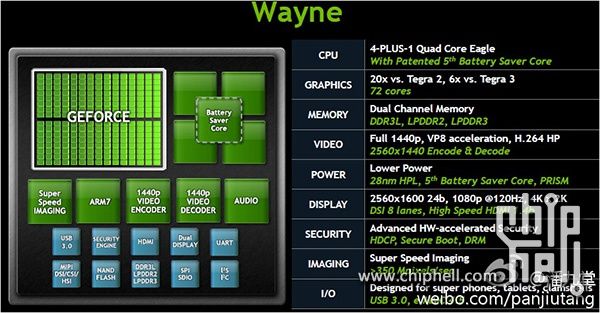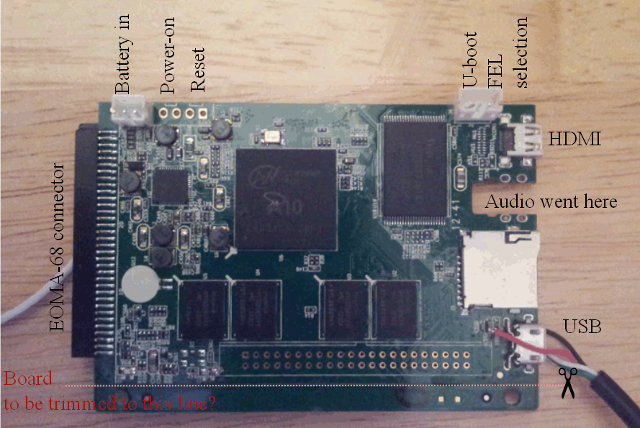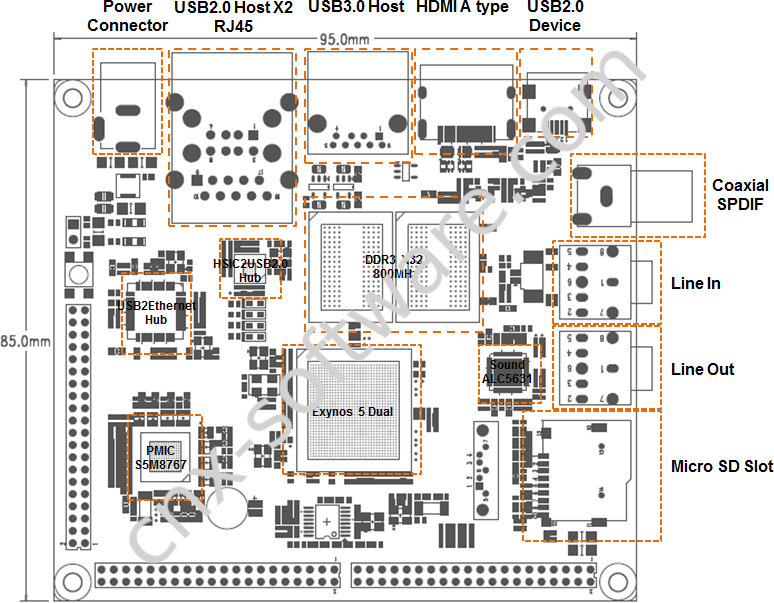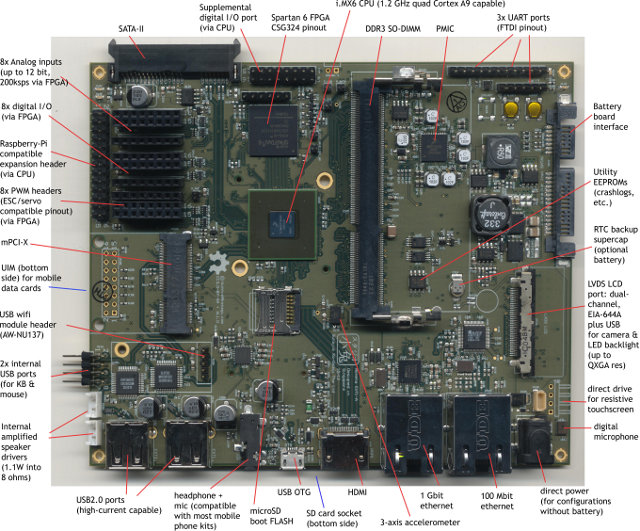According to Nvidia Tegra roadmap, the first Tegra 4 (T40) is due in Q1 2013, before T43 & AP40 come out in Q3 2013. Information is still sparse, but somebody posted a leaked slide on Chip Hell which gives a few more details about the upcoming Tegra 4 processors. So this is what we currently know about the Tegra T40 processor: CPU – 4x Cortex A15 (Eagle) cores @ 1.8 GHz + a battery saving core (aka companion core). GPU – Geforce GPU with 72 cores providing 20x Tegra 2 performance and 6x Tegra 3’s. Memory – Support for DDR3L, LPDDR2 and LPDDR3 Video – 1440p video encoding and decoding with VP8 and H.264 High Profile hardware acceleration Display – 2560×1600 24-bit, 1080p @ 120Hz, 4K displays via DSI and HDMI interfaces. Power – Lower power than previous generations thanks to 28nm HPL process (low power with high-k metal gates). Tegra […]
Rhombus Tech EOMA-68 CPU Card Prototype
Do you remember Rhombus Tech AllWinner A10 EOMA-PCMCIA CPU card that targets a BOM cost of $15 US, that was announced at the end of last year? Well, after much wait, the first prototype is now available. This CPU module is based on AllWinner A10 Cortex A8 processor, with 1GB RAM, a NAND Flash, one USB OTG port, microSD slot, HDMI, PMIC, an Ethernet PHY (at the back), an expansion header, and the EOMA-68 connector giving access to peripherals signals (SATA, Ethernet, RGB/TTL, I2C etc…). It can act as a Linux/Android stand-alone computer or be connected to a baseboard. One of the first project will be a laptop for the Chinese market. AllWinner A10 SoC may be a little underpowered to be used in laptop compared to the latest ARM processors, but since EOMA-PCMCIA is a standard, pin-to-pin compatible modules will eventually be designed and manufactured with different/faster (ARM) processors. […]
libavg on Raspberry Pi
libavg development team has recently announced a beta port of their multimedia library to the Raspberry Pi. libavg is a high-level development platform for media-centric applications using Python as scripting language and written in C++. I came to know this platform as I tried Xibo Digital Signage, and I tested it on ARM platforms. Up to know this would only work using software rendering/decoding, and everything was painfully slow on ARM, but libavg developers are now making use of OpenGL ES to boost graphics speed. More work is needed, and they intend to eventually support features such as hardware video decoding (OpenMAX possibly via gstreamer) and compressed textures. Installing libavg on Raspberry Pi. Pre-built packages are available for Raspberry, so installation is pretty straight forward:
|
1 2 3 4 5 |
sudo apt-get install libxml2 libpango1.0-0 librsvg2-2 libgdk-pixbuf2.0-0 \ libavcodec53 libavformat53 libswscale2 libboost-python1.49.0 \ libboost-thread1.49.0 libsdl1.2debian libxxf86vm1 wget https://www.libavg.de/site/attachments/download/190 -O libavg-raspberry.tar.bz2 sudo tar -C /usr/local -xjf libavg-raspberry.tar.bz2 |
Running Samples Apps 32 samples are located in /usr/local/lib/python2.7/dist-packages/libavg/samples/ directory, and they rely on X11, so first start LXDE:
|
1 |
startx |
Open a serial console (LXTerminal) […]
$135 ARMBRIX Exynos 5 Dual Cortex A15 Development Board
If you want to develop on a Cortex A15 processor, but Arndale development board is a bit expensive for you, don’t despair as ARMBRIX development board featuring Samsung Exynos 5 Dual processor is currently being developed and should be available in Q1 2013 for $135. The preliminary specifications include: SoC – Samsung Exynos 5 Dual Cortex A15 CPU + Mali T604 GPU System Memory – 2 GB DDR3 @ 800 MHz Storage – microSD slot Video Output – HDMI Audio In/Out – HDMI, SPDIF, Line In/Out. USB – 2x USB 2.0 Host, 1x USB 3.0 host and 1x USB 2.0 device Ethernet – Via USB to Ethernet hub. SATA – The connector is on the left of the micro SD slot. Expansions – 3 headers. Dimensions – 85 x 95 mm This board is based on Arndale design, and will be software compatible. Currently, Arndale officially support Android only, but […]
Build Your Own Freescale i.MX6 Quad Laptop
Andrew Huang (“Bunnie”) and others have been working on an open source laptop based on Freescale i.MX6 Quad processor since June, and they’ve recently got the motherboard. Beside featuring a powerful quad core ARM processor, the design files are also provided, so if you have the right skills and resources you can build it yourself. The open source laptop mainboard (Codename: Novena) has the following specifications: SoC – Freescale iMX6 Quad @ 1.2GHz with Vivante GC2000 GPU System Memory – 64-bit DDR3-1066 SO-DIMM, upgradable to 4GB Storage – microSD boot flash, SATA-II connector for hard drive / SSD, SD card reader and serial EEPROM (for storing crash logs and other bits of handy data). FPGA – Spartan-6 CSG324. It has several interfaces to the CPU, including a 2Gbit/s RAM-like bus. Internal ports & sensors: mini PCI-express slot UIM slot for mPCIx mobile data cards Dual-channel LVDS LCD connector (up to […]
SliTaz armhf: 46MB Linux Distribution for Raspberry Pi
SliTaz armhf is a minimal Linux distribution based on SliTaz Linux, that uses the hard-float ABI for the Raspberry Pi. The compressed SD card image is 46M, the rootfs 18.6 MB, and Slitaz uses just about 7 MB RAM after boot. Slitaz armhf rootfs comes pre-loaded with the following packages: busybox 1.20.2 dropbear 2012.55 – Light SSH client and server. nano 2.2.6 – GNU Nano Text Editor. retawq 0.2.6c – Text mode Web browser. tazpkg 5.0 – SliTaz packages manager (Tiny autonomous zone packages manager). ytree 1.97 – file manager for file and archives. Slitaz armhf comes with tazpkg package manager which allows to install packages just like you would do with apt-get in Raspbian. There are over 3,300 packages available for Slitaz (x86), and for now, over 250 packages are available for Slitaz armhf. Let’s get try it out. First, download slitaz-armhf-mini-2012-12-14.zip, extract it, and copy it to an […]
YotaPhone Dual Display (LCD + E-Ink) Smartphone Hands-on Video
In the last few days, there has been a lot of buzz about the YotaPhone, an upcoming Russian Android 4.2 smartphone featuring Snapdragon MSM8960 dual core processor with 2 GB RAM and 32/64 GB Flash. But the real innovation is the presence of 2 full 4.3″ displays: a standard LCD display on one side, and an E-Ink display on the other. Here are the preliminary specifications of the YotaPhone: SoC – Qualcomm Snapdragon S4 MSM8960 dual core Krait processor @ 1.5 GHz System Memory – 2GB RAM Storage – 32 or 64 GB NAND Flash Display 4.3″ LCD Display (1280×720) 4.3″ E-Ink EPD display Camera – 12MP front camera Connectivity Wi-Fi (Direct) Bluetooth NFC 2G, 3G and 4G (LTE) mobile networks Audio – 3.5mm headphone jack Battery – 2100 mAh. The device supports wireless charging. Dimensions – 67 x 131 mm Weight – 140 grams You may think a smartphone […]
Running Ubuntu in Android with ODROID-X Development Board
I’ve had several people asking me about running Linux on Android in the last few months, but I did not look into it into details, because I thought we would just be able to run server apps. That is until Rohith left a comment on CNX Software Facebook timeline, that it’s possible to run Linux in Android, and access the user interface via VNC (sort of simple, but I did not think of it). You probably need at least 1GB of memory and a multi-core processor to run this sort of setup correctly, so I finally decided to give it a try by running Ubuntu 12.04 with Unity interface in ODROID-X development board. I mainly followed the instructions available at http://linuxonandroid.org/ and inside the Android app. Most of the steps I followed can also be replicated on other rooted Android hardware platforms. Apart from Ubuntu 10.04 & 12.04, you can […]













